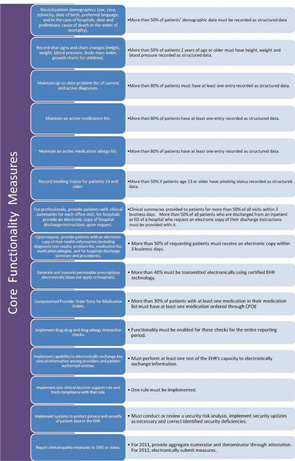For the Meaningful Use Objectives, the denominator is based on one of the following:
Simply reviewing a list of meaningful-use objectives and then working from there will not lead to success.
- Counting actions for patients whose records are maintained using certified EHR technology.
- Example measure: More than 40% of all permissible prescriptions written by the EP are transmitted electronically using certified EHR technology.
- What this means: The denominator includes all patients whose records are maintained in the certified EHR system. Other patients seen by the eligible provider but not recorded in the EHR (e.g., those with paper records) are not included in the denominator. For this measure, the denominator would include all of the permissible prescriptions, excluding controlled substances, for patients whose records are in the EHR system. The numerator would then identify how many of those prescriptions were generated and sent via electronic prescribing.
- All unique patients seen during the reporting period, regardless of whether the patient’s records are maintained using certified EHR technology.
- Example measure: More than 50% of all unique patients seen by the EP have demographics recorded as structured data.
- What this means: The denominator includes all unique patients seen during the reporting period, including those with both paper and electronic documentation. The eligible provider will need to generate a report of patient records stored in the EHR and also manually count any paper records for unique patients seen during the reporting period. The numerator would then assess how many of those patients have demographics entered into the EHR system as structured data.
- Count of actions for qualifying unique patients whose records are maintained in the certified EHR technology.
- Example measure: More than 30% of all unique patients with at least one medication in their medication list seen by the EP have at least one medication order entered using the computerized physician order entry (CPOE).
- What this means: This denominator refines “counting action” denominators, including only unique patients who meet additional criteria (e.g., a specified event). In this measure, the denominator includes all patients seen more than once by the EP and who have at least one medication in their medication list. The numerator would then assess how many of those patients had at least one medication entered via CPOE.
For those objectives that aren’t quantified using a percentage and performance threshold, the rule calls for reporting via yes/no attestation.
EPs Practicing in Multiple Locations
For those EPs practicing in multiple locations with certified EHR technology available for 50% or more of their total patient encounters during the reporting period, EHR reporting for Meaningful Use will only include those encounters where certified EHR systems are available at the start of the reporting period.
